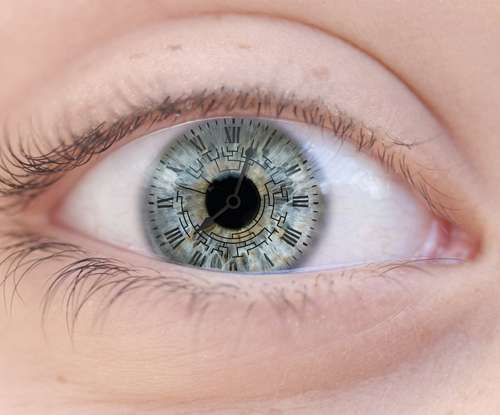Researchers show that time perception in animals depends on their pace of life

(Phys.org) —An international collaboration led by scientists from Trinity College Dublin including researchers from the University of Edinburgh and the University of St Andrews has shown that animals' ability to perceive time is linked to their pace of life.
The rate at which time is perceived varies across animals. For example, flies owe their skill at avoiding rolled up newspapers to their ability to observe motion on finer timescales than our own eyes can achieve, allowing them to avoid the newspaper in a similar fashion to the "bullet time" sequence in the popular film The Matrix. In contrast, one species of tiger beetle runs faster than its eyes can keep up, essentially becoming blind and requiring it to stop periodically to re-evaluate its prey's position. Even in humans, athletes in various sports have also been shown to quicken their eyes' ability to track moving balls during games.
The study which was just published in the leading international journal Animal Behaviour, showed that small-bodied animals with fast metabolic rates, such as some birds, perceive more information in a unit of time, hence experiencing time more slowly than large bodied animals with slow metabolic rates, such as large turtles.
Commenting on the findings, Assistant Professor at the School of Natural Sciences at Trinity College Dublin, Andrew Jackson, said: "Ecology for an organism is all about finding a niche where you can succeed that no-one else can occupy. Our results suggest that time perception offers an as yet unstudied dimension along which animals can specialise and there is considerable scope to study this system in more detail. We are beginning to understand that there is a whole world of detail out there that only some animals can perceive and it's fascinating to think of how they might perceive the world differently to us."
"Our results lend support to the importance of time perception in animals where the ability to perceive time on very small scales may be the difference between life and death for fast moving organisms such as predators and their prey," commented lead author Kevin Healy, PhD student at the School of Natural Sciences, Trinity College Dublin. This time perception ability can be shown to vary across all animals, using a phenomenon called the critical flicker fusion frequency. The phenomenon, based on the maximum speed of flashes of light an individual can see before the light source is perceived as constant, is the principle behind the illusion of non-flashing television, computer and cinema screens. This is also the reason pet dogs see flickering televisions, as their eyes have a refresh rate higher than the screen of the TV.
The researchers took advantage of this phenomenon to explain the observed variation in time perception across a broad range of animals, showing that animals that would be expected to be agile possess the most refined ability to see time at high resolutions.
Professor Graeme Ruxton of the University of St Andrews in Scotland, who collaborated on the research project, said "Having eyes that send updates to the brain at much higher frequencies than our eyes do is of no value if the brain cannot process that information equally quickly. Hence, this work highlights the impressive capabilities of even the smallest animal brains. Flies might not be deep thinkers but they can make good decisions very quickly."
Dr. Luke McNally from the University of Edinburgh adds: "Animals may also use variation in time perception to send covert signals, for example, many species using flashing lights as signals, such as fireflies and many deep-sea animals. Larger and slower predator species may not be able to decode these signals if their visual system isn't fast enough, giving the signallers a secret channel of communication."
More information: www.sciencedirect.com/science/ … ii/S0003347213003060
Journal information: Animal Behaviour
Provided by Trinity College Dublin

















